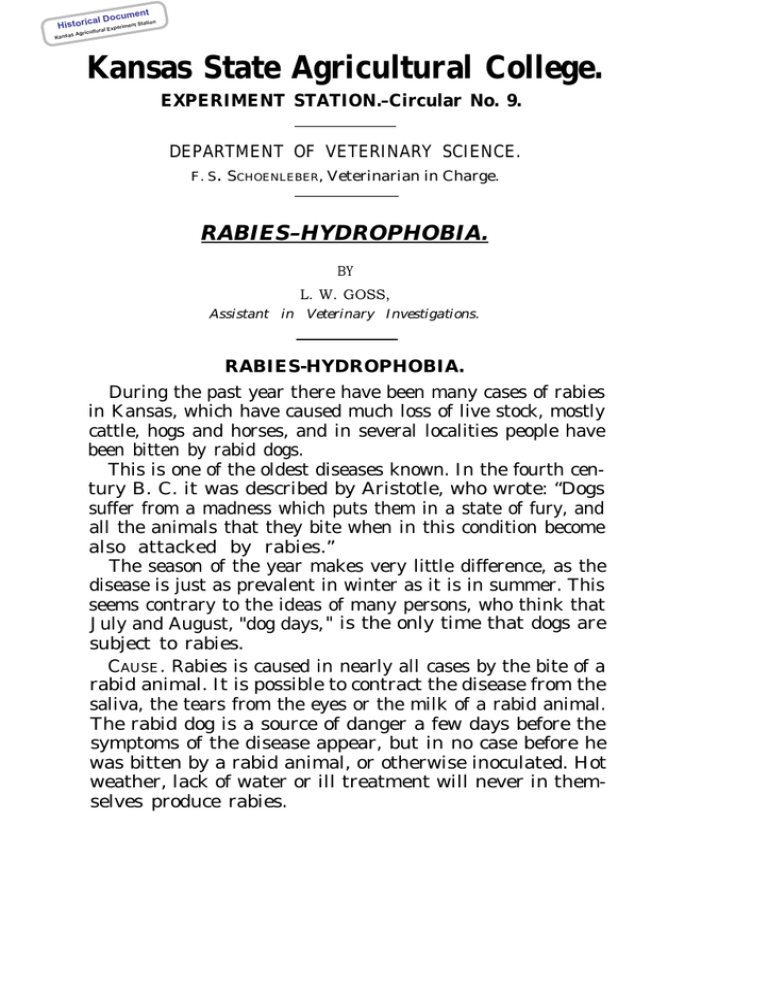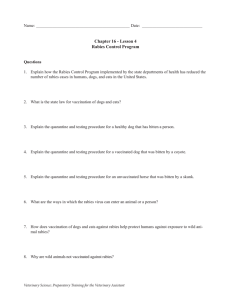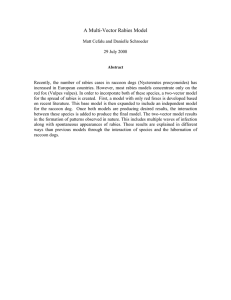Kansas State Agricultural College. RABIES–HYDROPHOBIA.
advertisement

t cumen on cal Do Histori ultural Agric Kansas ent Stati Experim Kansas State Agricultural College. EXPERIMENT STATION.–Circular No. 9. DEPARTMENT OF VETERINARY SCIENCE. F. S. SCHOENLEBER, Veterinarian in Charge. RABIES–HYDROPHOBIA. BY L. W. GOSS, Assistant in Veterinary Investigations. RABIES-HYDROPHOBIA. During the past year there have been many cases of rabies in Kansas, which have caused much loss of live stock, mostly cattle, hogs and horses, and in several localities people have been bitten by rabid dogs. This is one of the oldest diseases known. In the fourth century B. C. it was described by Aristotle, who wrote: “Dogs suffer from a madness which puts them in a state of fury, and all the animals that they bite when in this condition become also attacked by rabies.” The season of the year makes very little difference, as the disease is just as prevalent in winter as it is in summer. This seems contrary to the ideas of many persons, who think that July and August, "dog days, " is the only time that dogs are subject to rabies. CAUSE . Rabies is caused in nearly all cases by the bite of a rabid animal. It is possible to contract the disease from the saliva, the tears from the eyes or the milk of a rabid animal. The rabid dog is a source of danger a few days before the symptoms of the disease appear, but in no case before he was bitten by a rabid animal, or otherwise inoculated. Hot weather, lack of water or ill treatment will never in themselves produce rabies. t cumen on cal Do Histori ultural Agric Kansas ent Stati Experim 2 The dog is the principal source by which rabies is spread over the country. The freedom which he is given, his natural manner of self-protection, and his tendency to roam about bring him in contact with many other animals. Cats, hogs, horses and cattle, in the order named, are less dangerous than the dog. SYMPTOMS. The symptoms seldom develop in less than fourteen days after the animal was bitten—most commonly three to six weeks—but they may not show for six months to a year. Not all animals bitten develop the disease. It depends some upon the part of the body which was bitten. In man there is less danger if bitten through the clothing than upon the bare parts of the body, as the hands or face, the latter place being the most dangerous. It is not uncommon for the symptoms to develop in less than two weeks when bitten upon the head. The symptoms show in one of two forms—furious or dumb. FURIOUS RABIES . With the furious form the dog is at first noticed to seek the company of his master more than usual, or he will hunt dark, secluded places. Sometimes he will make sudden starts toward objects. These conditions last for a day or two. Later he becomes more restless, wanders about, and will often travel twenty to thirty miles in a day. While he is on this trip he is very likely to bite cattle, hogs and strange dogs, often passing horse and man, unless they interfere with his course. He will usually return home unless he is killed. During this period he is irritable, seldom eating or drinking, not because he does not want food or water, nor because he is afraid of water, for he is not, but from the fact that his throat is paralyzed and he cannot swallow. Often he will force sticks and stones down his throat in efforts to satisfy hunger and thirst. This period of irritation lasts for two or three days, followed by a period of paralysis, which has already taken place in the throat, as shown by the voice, which has already changed to a prolonged howl, and the inability to swallow. This is followed by paralysis of the hind legs, and later by entire paralysis and death, the entire symptoms lasting from four to ten days. DUMB RABIES. The dog seeks his master’s company or may hide in dark places, becomes unable to eat or drink, the lower jaw hangs down and tongue protrudes, which may swell and turn dark. This condition is followed by paralysis and t cumen on cal Do Histori Kansas t Stati perimen ural Ex Agricult 3 death in four to ten days after the first symptoms appear. Either form of the disease may change to the other in the same animal. SYMPTOMS. In Cattle. They are prone to chase chickens, dogs, and may run at man, whom they are less apt to attack. Often falling down from no apparent cause, twitching of muscles, inability to eat, due to paralysis, often showing signs of sexual excitement even when pregnancy is well advanced, but seldom biting. These symptoms are followed by paralysis and death. The Horse. Is often more vicious than cattle, biting the manger, himself, or anything within reach; also showing many of the same symptoms which are shown by cattle. The symptoms of rabies vary greatly, but in general there is a first stage of melancholia lasting two or three days, followed by a period of excitement which lasts two to three days more, followed by a period of paralysis. Death usually occurs inside of ten days after the first symptoms appear. DIAGNOSIS. This is made from microscopic examination of the brain, which shows small round or oval bodies from ¹/23000 to ¹/1000 of an inch in diameter. These are called Negri bodies, as they were first noticed by a man by the name of Negri in 1903. They have never been found in the brain of an animal unless the animal had been inoculated with rabies virus; therefore when Negri bodies are found in the brain of an animal there is no doubt that the animal had rabies. There are also changes in the nervous ganglia in the last stages of rabies. These changes are also found in other diseases, which makes this manner of diagnosis more uncertain and of little use in the early stages of the disease. Sticks and stones may be found in the stomach of a rabid dog. TREATMENT. This consists of a preventative treatment (Pasteur), which must be taken before the symptoms have developed. In order to be effective it should be taken within a few days after having been bitten by a rabid animal. The treatment may also be given to valuable domestic animals. The “mad stone” is of no use as a prevention of rabies. INSTRUCTIONS FOR SHIPPING . When it is of importance to know if a suspected animal had rabies an examination of the brain will be made if it is sent to the Veterinary Department t cumen on cal Do Histori ural Experiment Stati Kansas Agricult 4 and arrives in good condition and all express charges are prepaid. In preparing for shipment the head should be removed as soon after death as possible and wrapped in a cloth which is saturated with ten-per-cent formaline, placed in a tin box, and sealed. During warm weather the can should be placed in a box of ice. It should be shipped by express, charges prepaid, with a letter of explanation, addressed to the Veterinary Department of the Kansas State Agricultural College, at Manhattan. Approved: ED. H. WEBSTER, Director. MANHATTAN, KANSAS, July 9, 1910.




